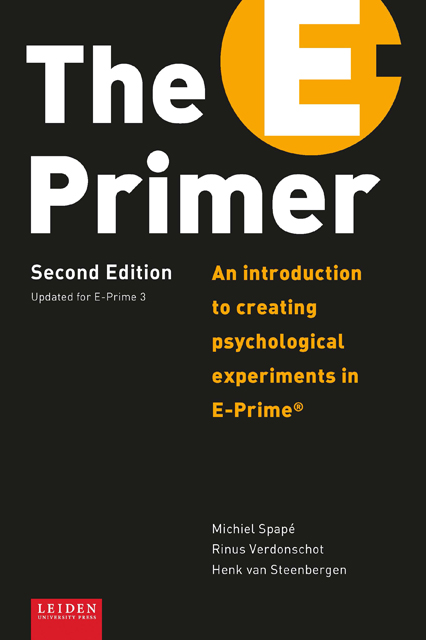Book contents
- Frontmatter
- Table of Contents
- Preface to the Second Edition
- Preface to the First Edition
- Introduction
- Chapter I E-Prime at a glance
- Chapter II List Attributes and Slides
- Chapter III Sound, movies, hardware, and nested Lists
- Chapter IV Beginning programming in E-Prime
- Chapter V Decision making in E-Basic
- Chapter VI Loops and Arrays in E-Basic
- Chapter VII Interactions between Slide objects and the Mouse
- Chapter VIII Various Input/Output devices
- References
- Appendix: Overview of available E-Objects
- About the authors
- Index
Chapter I - E-Prime at a glance
Published online by Cambridge University Press: 22 November 2022
- Frontmatter
- Table of Contents
- Preface to the Second Edition
- Preface to the First Edition
- Introduction
- Chapter I E-Prime at a glance
- Chapter II List Attributes and Slides
- Chapter III Sound, movies, hardware, and nested Lists
- Chapter IV Beginning programming in E-Prime
- Chapter V Decision making in E-Basic
- Chapter VI Loops and Arrays in E-Basic
- Chapter VII Interactions between Slide objects and the Mouse
- Chapter VIII Various Input/Output devices
- References
- Appendix: Overview of available E-Objects
- About the authors
- Index
Summary
In this chapter, you will learn
This chapter will introduce you to the E-Prime software package. You will get acquainted with the different programs that enable you to create, run and analyse experiments. You will learn that E-Prime uses object oriented programming to offer you the different elements that make up an experiment. These E-Objects function as building blocks that enable you to create your own experiments in a relatively simple and straightforward way. Before actually starting to program, it is important to visualise what your experiment will look like. Therefore, you will first learn how to conceptualise your experiment, which makes the actual programming part of it a lot easier. After reading this chapter, you should be able to program, run and analyse your own first experiment.
E-Studio, E-DataAid, E-Recovery and E-Merge
When we say we are ‘working in E-Prime’, talk about ‘an experiment written in E Prime’, or even complain that ‘E-Prime has crashed again’, we generally mean E-Studio. You may be delighted – or disheartened – to learn that E-Prime is actually a suite of software, composed of a number of programs besides just E-Studio. We will talk about these other programs throughout this book, but, generally, they are pretty straightforward and a quick summary should be enough to get you started.
E-Studio is based on (or perhaps merely inspired by) Visual Studio and can therefore be called an IDE: an integrated development environment. The graphical user interface is a convenient way to code (develop) the experiment, which you can do by simply dragging and dropping objects onto a timeline. This makes the daunting task of developing experiments as simple and user-friendly as familiar Windows programs like PowerPoint – at least, on the face of it. However, it's not quite true that no real programming (i.e. coding or scripting) is required: almost all original experiments will at some point require you to write at least a few lines of code; and, more importantly, doing so can save you a lot of time. We will see how this works in later chapters. The experiment in E-Studio is stored as an .es3 file (.es or .es2 file in E-Prime 1 and 2).
- Type
- Chapter
- Information
- The E-PrimerAn Introduction to Creating Psychological Experiments in E-Prime, pp. 17 - 48Publisher: Amsterdam University PressPrint publication year: 2019



